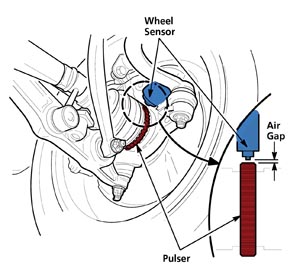During light braking on Acura vehicles, a wheel sensor that detects a faulty or intermittent low-speed signal can make the ABS control unit “think” the affected wheel is turning slower than the rest. To make all wheels turn at the same speed, the ABS then modulates the brake fluid pressure to that wheel, causing the pedal kickback to be felt with normal ABS activation.
Applies to: All Acuras with ABS, except SLX.
To diagnose this condition, you first need to know which wheel sensor is sending the faulty signal. Use your tester to pinpoint the sensor on systems without an ABS reservoir. On systems with an ABS reservoir, jump the ABS inspection connector with a multimeter. Once you’ve located the sensor in question, perform the following steps.
 Service Procedure:
Service Procedure:
1. Measure the air gap between the wheel sensor and the pulser. Refer to the appropriate S/M for specs and measuring details. See Fig. 1.
2. If the air gap is OK, check the pulser for dents or scratches.
3. If the pulser is OK, check the resistance between the wheel sensor’s terminals. Refer to the appropriate S/M for specs.
4. If the resistance is OK, check the wheel sensor circuit for an intermittent short to ground.
5. If the circuit is OK, replace the wheel sensor.
Courtesy of American Honda Motor Company.












